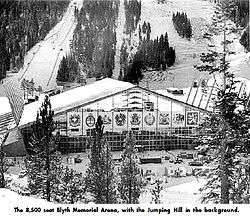Blyth Arena
 | |
| Location |
Squaw Valley, California, |
|---|---|
| Capacity | 8,500 |
| Construction | |
| Built | 1959 |
| Opened | 1960 |
| Closed | 1983 |
Blyth Arena was an ice skating arena in Squaw Valley, California. It was built in 1959 as venue for the ice hockey, the figure-skating competitions and the opening and closing ceremonies at the 1960 Winter Olympics and held 8,500 people. Standing-room crowds of 10,000 people were reported for the hockey games between the U.S. and the Soviet Union (on the second-to-last day of the 1960 Winter Olympics) and the U.S.-Czechoslovakia hockey game during the final day.
Named for Charles R. Blyth, an investment banker who led the California Olympic Commission,[1] Blyth Arena was open on its south side, enabling a view of the mountains. The 400m speed skating track was just to the south of the open side of the arena. This side of the arena also faced the 70m and 90m ski jumps and the slopes of Squaw Valley now known as the Red Dog. Following the Olympic Games the wood constructed ski jump facilities were left unmaintained and slowly deteriorated over time. In 1963 the 400m speed skating track was replaced by a parking lot in spite of protests from California speed skaters; since at the time it was known to be the only mechanically frozen 400m track in the country. From 1963 to 1983, the Squaw Valley ski area operator appealed regularly to the state of California to have the arena torn down to provide still more parking.
Destruction
In 1982 the U.S. Department of Agriculture made a push for energy conservation. One part of that program was funding to improve insulation on many buildings. The U.S. Forest Service received some of that money to insulate the roof of the arena and the next year the roof collapsed. What was not appreciated at the time was that the roof was not built to hold much snow, but had survived for 23 years without a problem. The plan had always been that heat generated from the ice chilling equipment in the arena traveled to the ceiling, warmed the uninsulated roof, and melted the snow. With the energy conservation measures in place, the snow did not melt due to waste heat and the building collapsed under the weight.
The arena was demolished in 1983 after the roof collapsed due to snow accumulation. The site is now a parking lot for the Squaw Valley ski resort.
Although gone, Blyth Arena is remembered as playing a major role in Olympic ice-hockey history, and to a lesser extent, in Olympic figure-skating history, where the host country won the men's (David Jenkins) and women's (Carol Heiss) individual titles.
In addition to its use by the Olympics, the arena was for several years a site for the Worldwide Church of God's annual Feast of Tabernacles. Evangelists Herbert W. Armstrong and Garner Ted Armstrong spoke at the arena several times during the period that the Feast of Tabernacles was held in Squaw Valley.
Replacement
There is a new ice arena at High Camp at the top of the cable car tramway, at 2500 meters. This rink is essentially an outdoor rink. It is covered during late spring, summer and early fall. The roof panels are removed for the winter or the wind could potentially remove them. There is a set of Olympic rings hanging at this rink causing many people to think that the 1960 Olympic figure skating and hockey were conducted on this new ice rink even though there is no seating around the rink nor any way for spectators to have accessed the rink in 1960.
References
- ↑ Shurtleff, William (2005). The Shurtleff and Lawton Families: Genealogy and History. Pine Hill Press. p. 197.
- 1960 Winter Olympics official report. p. 121.
- "Family Fun at Squaw Valley". Smith, Lynn. Los Angeles Times. 24 February 1991. Accessed 27 October 2010.
Coordinates: 39°11′51″N 120°13′58″W / 39.197477°N 120.232703°W

